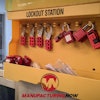How to avoid the number one mistake when mounting a wrap spring clutch/brake
Wrap spring clutch/brakes are commonly found in a wide range of repeating industrial applications. For a single stop design, the unit will rotate 360 degrees and stop once for each signal. Repeatability is within a half degree and any error will not accumulate.
These features make wrap spring clutch/brakes excellent for applications that require the same movement every cycle. Common installations are on labelers, imprinters, die-cutters, staplers and index systems. In each case the unit must move the same distance every cycle.
One of the key challenges in using wrap spring clutch/brakes is that the unit mounting plate implies a method for mounting that is exactly wrong. All wrap spring clutch/brakes are designed with a rectangular backing plate that supports the actuator, the solenoid and the body of the clutch/brake. This basic design has been the standard since at least the early 1970s, so changing now would be a hardship for many customers.
In addition to supporting the clutch/brake mechanism, the backing plate serves as a torque arm for the unit. It keeps the unit from rotating. However, the rectangular design with the four holes implies that the unit should be mounted rigidly to the machine frame. Many customers do just that, and those customers experience poor unit performance and reduced clutch/brake life as a result. In fact, over 50% of non-wear wrap spring clutch/brake failures are related to incorrect mounting.
To continue reading the full article, click here to visit our partner publication, IMPO.






















